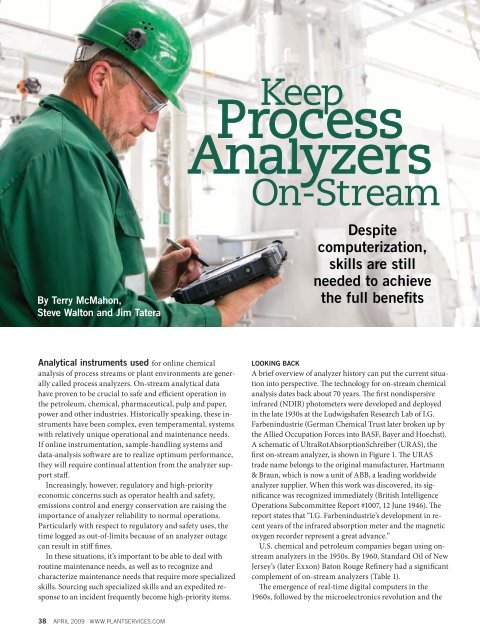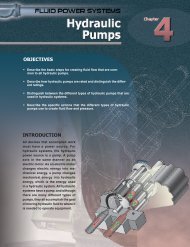POWER UP A WINNER - Plant Services
POWER UP A WINNER - Plant Services
POWER UP A WINNER - Plant Services
You also want an ePaper? Increase the reach of your titles
YUMPU automatically turns print PDFs into web optimized ePapers that Google loves.
By Terry McMahon,<br />
Steve Walton and Jim Tatera<br />
Despite<br />
computerization,<br />
skills are still<br />
needed to achieve<br />
the full benefits<br />
Analytical instruments used for online chemical<br />
analysis of process streams or plant environments are generally<br />
called process analyzers. On-stream analytical data<br />
have proven to be crucial to safe and efficient operation in<br />
the petroleum, chemical, pharmaceutical, pulp and paper,<br />
power and other industries. Historically speaking, these instruments<br />
have been complex, even temperamental, systems<br />
with relatively unique operational and maintenance needs.<br />
If online instrumentation, sample-handling systems and<br />
data-analysis software are to realize optimum performance,<br />
they will require continual attention from the analyzer support<br />
staff.<br />
Increasingly, however, regulatory and high-priority<br />
economic concerns such as operator health and safety,<br />
emissions control and energy conservation are raising the<br />
importance of analyzer reliability to normal operations.<br />
Particularly with respect to regulatory and safety uses, the<br />
time logged as out-of-limits because of an analyzer outage<br />
can result in stiff fines.<br />
In these situations, it’s important to be able to deal with<br />
routine maintenance needs, as well as to recognize and<br />
characterize maintenance needs that require more specialized<br />
skills. Sourcing such specialized skills and an expedited response<br />
to an incident frequently become high-priority items.<br />
Looking back<br />
A brief overview of analyzer history can put the current situation<br />
into perspective. The technology for on-stream chemical<br />
analysis dates back about 70 years. The first nondispersive<br />
infrared (NDIR) photometers were developed and deployed<br />
in the late 1930s at the Ludwigshafen Research Lab of I.G.<br />
Farbenindustrie (German Chemical Trust later broken up by<br />
the Allied Occupation Forces into BASF, Bayer and Hoechst).<br />
A schematic of UltraRotAbsorptionSchreiber (URAS), the<br />
first on-stream analyzer, is shown in Figure 1. The URAS<br />
trade name belongs to the original manufacturer, Hartmann<br />
& Braun, which is now a unit of ABB, a leading worldwide<br />
analyzer supplier. When this work was discovered, its significance<br />
was recognized immediately (British Intelligence<br />
Operations Subcommittee Report #1007, 12 June 1946). The<br />
report states that “I.G. Farbenindustrie’s development in recent<br />
years of the infrared absorption meter and the magnetic<br />
oxygen recorder represent a great advance.”<br />
U.S. chemical and petroleum companies began using onstream<br />
analyzers in the 1950s. By 1960, Standard Oil of New<br />
Jersey’s (later Exxon) Baton Rouge Refinery had a significant<br />
complement of on-stream analyzers (Table 1).<br />
The emergence of real-time digital computers in the<br />
1960s, followed by the microelectronics revolution and the<br />
38 APRIL 2009 www.PLANTSERVICES.com












